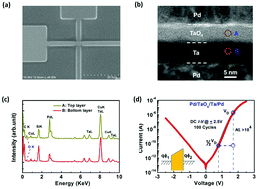Conduction mechanism of a TaOx-based selector and its application in crossbar memory arrays
Abstract
The conduction mechanism of a Pd/TaOx/Ta/Pd selector device, which exhibits high non-linearity (∼104) and excellent uniformity, has been systematically investigated by current–voltage–temperature characterization. The measurement and simulation results indicate two dominant processes of selector current at opposite biases: thermionic emission and tunnel emission. The current–voltage–temperature behaviors of the selector can be well explained using the Simmons’ trapezoidal energy barrier model. The TaOx-based selective layer was further integrated with a HfO2-based resistive switching layer to form a selector-less resistive random access memory (RRAM) device structure. The integrated device showed a reliable resistive switching behavior with a high non-linearity (∼5 × 103) in the low resistance state (LRS), which can effectively mitigate the sneak path current issue in RRAM crossbar arrays. Evaluations of a crossbar array based on these selector-less RRAM cells show less than 4% degradation in read margin for arrays up to 1 Mbit in size. These results highlight the different conduction mechanisms in selector device operation and will provide insight into continued design and optimization of RRAM arrays.


 Please wait while we load your content...
Please wait while we load your content...